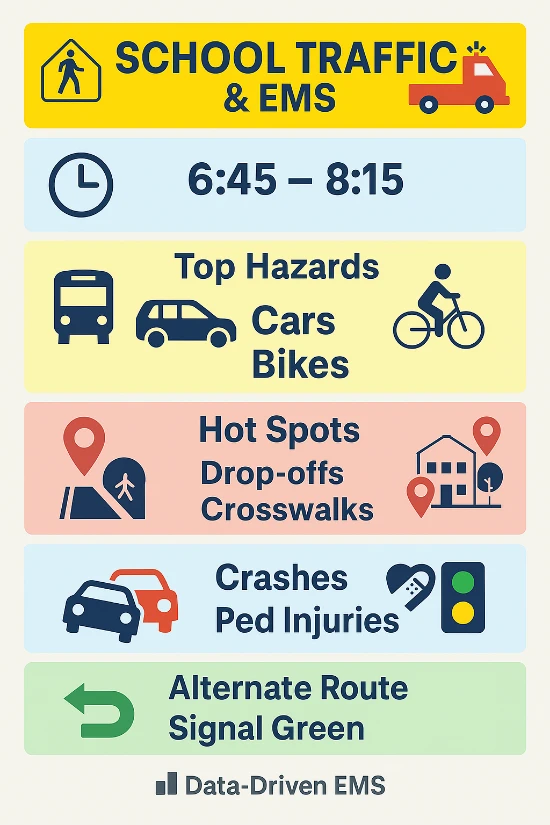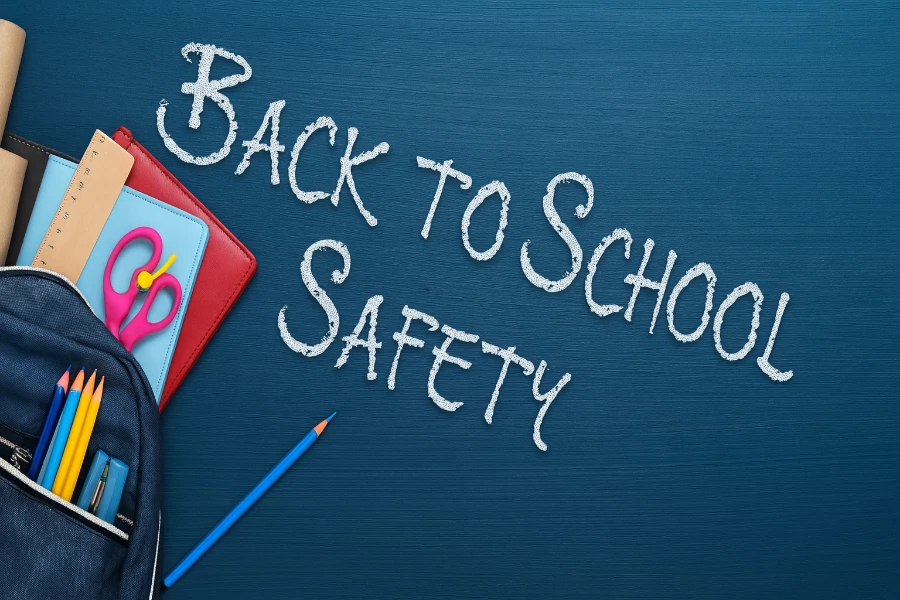Key Takeaways
- Back-to-school traffic surges create predictable congestion peaks, so EMS must adjust dispatch times and staging zones to maintain rapid response.
- Seamless coordination with schools, traffic engineers, and law enforcement enables signal preemption, clear access lanes, and unified emergency plans.
- Ongoing data analysis and joint drills refine routing strategies, reduce response delays, and build long-term resilience for school-zone incidents.
Unfolding the Back-to-School Traffic Surge
Morning and Afternoon Congestion Peaks
Every August school bells reset regional traffic rhythms, and early commuters immediately feel the difference. Because buses enter roadways before sunrise, intersections near campuses experience thirty-percent longer green-to-red cycles. Meanwhile, parents queue along curb lanes, which squeezes through lanes and creates rolling bottlenecks for emergency vehicles. Drivers glance at school schedules instead of mirrors, which increases minor fender-benders during the first two weeks. Therefore, EMS dispatchers flag morning peaks between 6:45 and 8:15, and afternoon spikes spanning 2:00 to 3:30.
Changes in Traffic Patterns and Risk Zones
Because school administrations adjust bus stops annually, EMS route databases must update before opening day arrives. Planners notice temporary cones converting two-lane streets into one-way drop-off corridors, which complicates ambulance staging. Therefore, crews survey new layouts during orientation week, documenting curb heights, signage, and restricted U-turn points. Next, supervisors flag construction zones near campuses, since renovation projects sometimes block hydrant access or helipad clearances. Meanwhile, crossing guards create dynamic risk zones, as children dart unpredictably despite adult directions. Because these micro-hazards shift daily, GPS overlays using live road imagery improve navigation confidence for responders.
Understanding Crash and Call Volume Trends
Data-Driven Insights from Traffic Studies
Researchers from the National Highway Traffic Safety Administration report over 100 school-transportation-related fatalities annually, many involving children outside the bus. Since half of those incidents involve teen drivers, injury severity often rises because experience levels remain low. Therefore, EMS agencies allocate extra advanced life support units during dismissal hours to handle higher acuity calls. Analysts correlate weather patterns with crash density, and rainy first weeks amplify skid-out events on freshly painted crosswalks. Consequently, agencies integrate meteorological alerts with dispatch software, creating multi-factor risk scores that guide pre-positioning.
Local vs. Regional Differences in Call Volume
Urban districts see congestion revolve around subway stations and rideshare pickups, which creates multi-modal hazards for responders. Meanwhile, suburban areas struggle with sprawling parent queues that snake through parking lots and onto main boulevards. Because rural counties rely on long bus routes, EMS teams often travel farther to reach incidents but face lighter car density. Therefore, shift supervisors tailor crew distribution, assigning bike medics downtown and extra ambulances near suburban school clusters. Next, monthly performance dashboards compare response times across regions, fostering data-driven staffing adjustments for future semesters. Consequently, managers avoid one-size-fits-all plans and instead apply localized solutions respecting unique traffic ecologies.
Coordination Between EMS, Schools, and Traffic Management
Integrating with School Emergency Operation Plans
Since federal guidelines require districts to include EMS, planners invite medical officers to yearly tabletop drills. During these sessions, responders review evacuation maps, reunification zones, and traffic flow diagrams for accuracy. Therefore, crews receive radio frequencies and master keys, ensuring swift gate entry when seconds count. Administrators share bell schedules and major event calendars, allowing EMS to anticipate football nights or science-fair crowds. Consequently, integrated plans reduce confusion during real incidents because everyone references identical documents. Next, schools update contact trees, so dispatchers immediately reach the correct staff liaison in an emergency.
Working With Traffic Engineers and Law Enforcement
Traffic engineers program signal preemption near campuses, so approaching ambulances gain early green lights during peak flows. Meanwhile, law enforcement stations officers at chokepoints, clearing parent vehicles that block intersection boxes. Because agencies coordinate weekly, field feedback quickly translates into adjusted cone placements or sign relocations. Therefore, responders drive predictable corridors without sudden detours, reducing response variance. Next, departments hold after-action reviews to measure how design tweaks influence average travel speeds. Consequently, success stories spread across municipalities, encouraging wider adoption of collaborative traffic solutions.
On-Road Tactics for EMS During School Days

Dynamic Route Planning and Dispatch
Dispatch algorithms prioritize alternate arterials that parallel school zones, thereby avoiding the densest curb congestion. Because live traffic feeds update every thirty seconds, route guidance recalibrates when crashes block primary lanes. Therefore, units depart even before patient confirmation in suspected high-acuity calls, gaining minutes over standard procedures. Next, dispatchers stagger non-emergent hospital transfers outside school commute windows, preserving bandwidth for true 911 traffic. Consequently, system strain lessens, and emergency vehicles more easily navigate remaining choke points. Meanwhile, geofencing alerts remind crews to reduce speed near active crossing guards, protecting vulnerable pedestrians.
Intersection and Crosswalk Protocol Adjustments
Drivers sometimes freeze at lights when sirens activate, so crew chiefs announce approach direction on external speakers. Because optical emitters override signals, ambulances still slow at every crosswalk to confirm pedestrian clearance. Therefore, units angle noses toward centerlines, discouraging trailing cars from shadowing emergency lanes. Next, medics maintain eye contact with crossing guards, using hand signals to coordinate safe passage. Consequently, public trust rises when citizens observe courteous yet efficient emergency driving. During policy reviews, supervisors reinforce these habits with dash-cam footage and peer coaching.
Vehicle and Crew Readiness During Commute Peaks
Before the morning bell rings, crew leaders complete fuel checks and emergency light inspections. Because minor mechanical failures during gridlock cripple response capacity, mechanics schedule preventive service during midday lulls. Therefore, spare vehicles stage near populated school clusters, ready to replace any downed unit. Meanwhile, crews keep pediatric jump bags within arm’s reach, anticipating child patients during these peak hours. Next, shift briefings highlight weather forecasts, so everyone anticipates slick pavement or reduced visibility. Consequently, readiness procedures create a safety net that cushions inevitable surprises of back-to-school traffic.
The table below highlights how traffic peaks align with distinct EMS call types and mitigation tactics throughout a typical school day. Use it as a quick-reference scheduling tool when planning unit deployment and public-safety outreach.
| Time Window | Top Road Hazards | Typical EMS Calls | Proactive Measures |
|---|---|---|---|
| 06:45 – 08:15 | Bus merges, parent drop-offs, low sunrise glare | Fender-benders, pedestrian bumps, asthma flare-ups | Stage ALS unit on side street; issue live radio reminders about school zones |
| 10:00 – 12:30 | Field-trip buses, cafeteria vendor deliveries | Playground fractures, allergic reactions | Keep pediatric jump bag stocked; post QR code flyers for allergy action plans |
| 14:00 – 15:30 | Parent queues, teen drivers, bike exodus | Rear-end crashes, cyclist injuries, heat exhaustion | Activate signal preemption; deploy bike medics near exit gates |
| 18:00 – 21:30 | Sports event traffic, low lighting, distracted parking | Sprains, dehydration, post-game collisions | Station first-aid cart at stadium; coordinate with athletic trainers for rapid access |
Medical Response in School Zone Scenarios
Injury Patterns Specific to School Commutes
Population-based EMS research confirms that delayed response correlates with worse trauma outcomes in school-area crashes. Because vehicles travel slowly, blunt force trauma dominates while high-velocity injuries remain rare. Therefore, medics prioritize cervical stabilization and quick neuro checks, spotting subtle concussions early. Next, crews carry child-sized immobilization devices, ensuring proper fit and comfort. Meanwhile, allergic reactions from packed lunches occasionally trigger calls, so teams keep epinephrine pens stocked. Consequently, knowledge of typical patterns guides supply decisions and assessment priorities.
Scene Access Challenges and Solutions
Often, parents double-park near entrances, blocking curb access just when ambulances arrive. Because those drivers may panic, officers quickly clear a lane, while medics stage equipment at distance. Therefore, responders deploy wheeled stretchers with all-terrain wheels for narrow sidewalks. Next, crews use high-visibility vests and portable LED beacons to command attention within chaotic scenes. Meanwhile, traffic cones dropped by first arriving patrol cars create buffer zones that protect patient and provider. Consequently, rehearsed coordination between agencies eliminates dangerous delays inherent in crowded school environs.
Community Engagement and Public Education
Parental Awareness Campaigns
Communications staff launch social media infographics that remind parents to stay off phones in pickup lines. Because many parents follow school pages, these posts reach the target audience with minimal advertising cost. Therefore, agencies pair visuals with short videos showing ambulances navigating mock drop-off zones. Next, back-to-school nights include brief safety talks where medics hand out reflective backpack tags. Meanwhile, local news outlets film these segments, amplifying the message regionally. Consequently, consistent reminders shape safer habits long before September congestion peaks.
Student and Staff Preparedness Programs
Educators invite crews to teach stop-look-listen drills during PE classes, reinforcing pedestrian awareness. Because hands-only CPR saves lives, instructors also certify senior students before graduation. Therefore, staff practice lockdown and evacuation routes alongside medical personnel, ensuring clarity of roles. Next, bus drivers receive first-aid refreshers that focus on epi-pen use and bleeding control. Meanwhile, feedback surveys drive iterative improvements, so future sessions always address emerging concerns. Consequently, school communities build a culture of shared responsibility around traffic and emergency readiness.
After-Call Review and Safety Monitoring
Incident Reporting Specific to School Traffic
The National EMS Dashboard tracks crash data and activation trends, informing how school-zone incidents are categorized. Because standardization matters, supervisors enforce consistent taxonomy across every shift. Therefore, analysts later query the database and produce precise heat maps of delays. Next, leadership reviews patterns monthly, sharing lessons learned during department briefings. Meanwhile, school officials receive anonymized summaries that validate or challenge their traffic plans. Consequently, transparency encourages joint accountability and continuous improvement.
Using Data to Refine Future Planning
Analysts blend crash statistics, response times, and citizen complaints to forecast next semester’s risk clusters. Because predictive analytics require quality inputs, data teams verify timestamp accuracy and location precision. Therefore, planners adjust unit schedules, adding rover cars where algorithms predict congestion. Next, agencies compare before-and-after metrics, measuring effectiveness of every new traffic intervention. Meanwhile, success metrics feed grant applications, securing funds for advanced signal preemption tools. Consequently, data loops close the gap between observation and action, fostering evidence-driven policy.
3 Practical Tips
- Schedule one rapid-response unit near each major campus during dismissal, reducing travel distance through congested corridors.
- Use geofenced alerts that buzz crew tablets fifteen minutes before bell times, cueing route adjustments.
- Hold five-minute safety huddles at 13:30 daily, ensuring everyone reviews updated traffic maps and weather forecasts.
Frequently Asked Questions
How can EMS quickly enter busy school zones at peak times?
Dispatchers request traffic officers to secure entry points one block ahead of approaching units. Crews follow predetermined side-street detours that bypass parent queues and align with preemption signals.
What measures reduce response delay during school drop-off?
Engineers extend green phases on designated rescue corridors, so ambulances cross school zones without unnecessary braking. Supervisors also schedule non-emergent transports outside drop-off windows to keep priority lanes clear.
Do pediatric guidelines change for school-related trauma?
Standard pediatric protocols remain valid, but crews emphasize spinal motion restriction because playground surfaces vary. Medics carry child-sized collars and reassess neuro function every five minutes during transport.
How often should EMS train with schools for route drills?
Agencies conduct joint drills each August to prepare for fall traffic shifts. Quick refreshers in spring evaluate midyear construction changes and staffing turnovers.
Building Long-Term Resilience for School Commutes
Incorporating School Season Scenarios in Annual Training
Training officers script tabletop exercises that simulate simultaneous incidents at multiple campuses during peak traffic. Because realism matters, facilitators inject curveballs like sudden weather shifts or bus malfunctions. Therefore, crews practice decision trees for resource allocation under constrained road access conditions. Next, evaluators score performance metrics, then deliver feedback within twenty-four hours. Meanwhile, lessons learned feed continuous education modules on the learning management system. Consequently, annual repetition embeds muscle memory for complex school commute challenges.
Investments in Tech Tools and Interoperability
Agencies purchase computer-aided dispatch plugins that display live school zone speeds and crossing guard status. Because hardware alone fails without cooperation, IT teams share data feeds with police and transportation departments. Therefore, everyone accesses identical situational dashboards, which prevents conflicting directives during emergencies. Next, grant funding supports portable signal preemption devices with secure authentication keys. Meanwhile, periodic penetration tests safeguard networks against potential cyber threats targeting public infrastructure. Consequently, technology upgrades translate into measurable cuts in response times.
Paving Pathways for Ongoing Collaboration
Stakeholders host quarterly roundtables where parents, teachers, engineers, and medics openly discuss traffic pain points. Because dialogue builds trust, solutions arise that respect each group’s constraints. Therefore, new signage, staggered bell schedules, or additional crossing guards gain consensus quickly. Next, agencies document action items and assign responsible parties with deadlines. Meanwhile, progress dashboards remain public, ensuring accountability and transparency. Consequently, collaborative culture proves vital for sustained back-to-school traffic safety.

Jeromy VanderMeulen is a seasoned fire service leader with over two decades of experience in emergency response, training, and public safety management. He currently serves as Battalion Chief at the Lehigh Acres Fire Control & Rescue District and is CEO of the Ricky Rescue Training Academy, a premier provider of online and blended EMT and firefighter certification programs in Florida.
Jeromy holds multiple degrees from Edison State College and the Community College of the Air Force, and is pursuing his MBA at Barry University. He maintains top-tier certifications, including Fire Officer IV, Fire Instructor III, and Fire Inspector II, and has served as a subject matter expert for a court case. He is a member or the Florida Fire Chiefs Association.
Jeromy also contributes to state-level fire safety regulation and serves on several hiring and promotional boards.

